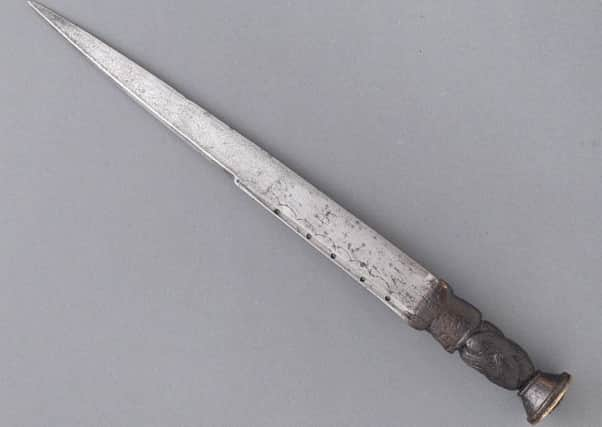Jacobite dirk to go under the hammer at US auction


The fearsome weapon, with a blade more than a foot long, worn and pitted from years of use, and a grip hewn from ancient bogwood, also chipped and split, is inscribed in Gaelic with the earliest battle cry of the Fraser of Lovat clan - followers of the turncoat Scottish Jacobite Simon Fraser, 11th Lord of Lovat.
Fraser was executed in 1747 at Tower Hill in London.
Shortly before the axeman stuck, a grandstand erected for the benefit of spectators to the event suddenly collapsed, resulting in the death of 20 people, much to the amusement of Fraser, then in his 80th year.
Advertisement
Hide AdAdvertisement
Hide AdHis gallows mirth is credited as the origin of the saying “laughing your head off”.
A famous etching by William Hogarth shows him awaiting execution in The Tower.
The classically-educated Fraser, known for his violent feuding, his changes of allegiance, and for the rape and forced marriage of the widow of the 9th Lord Lovat, an unsavoury incident which resulted in his prosecution by her powerful family, the Murrays, owed his very title to a dirk.
At a banquet at Beauly soon after the Battle of Killiecrankie in 1689, his older brother Alexander drew his dirk after taking offence about a satirical song the man was playing, which he thought was a personal affront.
While he later maintained that he meant only to puncture the bagpipes and stop the music, the piper was fatally stabbed. Fearing execution, Alexander fled to Wales and vanished. With his older brother out of the way, Simon became heir apparent.
In 1715, Simon, who was nicknamed “The Fox”, had been a supporter of the House of Hanover, but in 1745 he changed sides and supported the Stuart claim. He was among the Jacobites defeated at Culloden and was convicted of treason against the Crown.
When he had stopped laughing after the Tower Hill stand collapse, he proclaimed “Dulce et decorum est pro patria mori”, a line from the Roman lyrical poet Horace, which can be roughly translated into English as “It is sweet and right to die for your country”, and laid his head upon the block.
The bogwood-handled dirk has surfaced at Bonhams Auction House in San Franciso, and will go under the hammer there on June 8th, in the firm’s Antique Arms, Armour and Modern Sporting Guns sale. It is expected to fetch up to POUNDS 3,500.
Advertisement
Hide AdAdvertisement
Hide AdJames Ferrell, Arms and Armour Specialist at Bonhams said it had been consigned for sale by an American collector who purchased it some years ago from well- known dealer in London.
The words “A Mhor Fhaiche” can be found inscribed on the broad spine of the weapon, meaning “The Great Field”, the Fraser of Lovat clan’s oldest battle cry, a reference to the large field near Lovat Castle in Inverness-shire where members used to assemble for war.
The sides of the blade are incised with a series of curved lines, one side additionally incised with “an indecipherable mark”.
Experts say that whether it is actually the one used by Alexander Fraser to stab the piper, another personally held by Simon Fraser, or simply belonged to one of the clan’s many followers is “pure speculation”.
Mr Ferrell said: “Anything is possible but that is not something I would want to make an opinion about.”